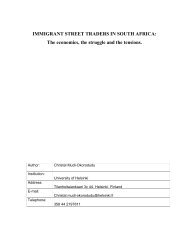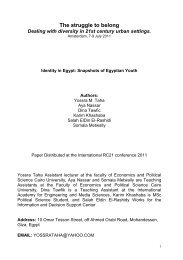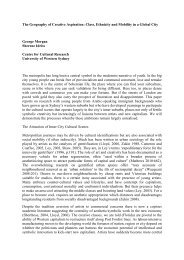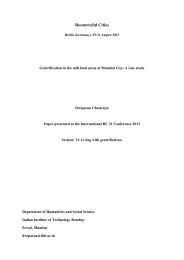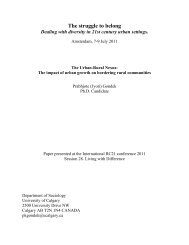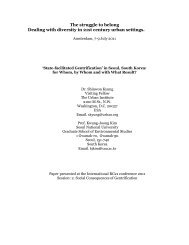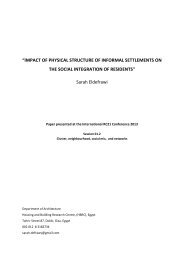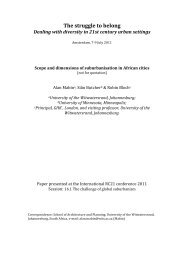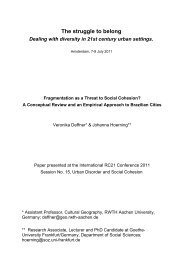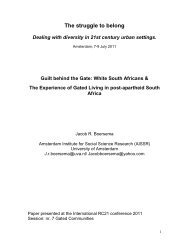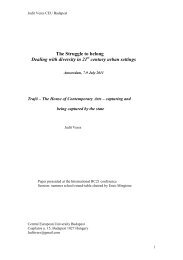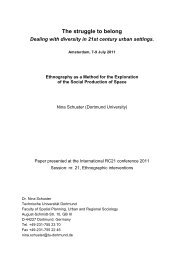The hidden side of metropolization. Governing squats and slums in ...
The hidden side of metropolization. Governing squats and slums in ...
The hidden side of metropolization. Governing squats and slums in ...
You also want an ePaper? Increase the reach of your titles
YUMPU automatically turns print PDFs into web optimized ePapers that Google loves.
5<br />
2007; Adell <strong>and</strong> Mart<strong>in</strong>ez, 2004; Vivant, 2008) or hous<strong>in</strong>g right protests (Péchu, 2001, 2006, 2009,<br />
2010). <strong>The</strong> ma<strong>in</strong> purpose <strong>of</strong> these studies is to analyze the organization <strong>of</strong> squatt<strong>in</strong>g, their stories <strong>and</strong><br />
the discourses <strong>of</strong> squatters <strong>in</strong> order to underst<strong>and</strong> this urban practice. <strong>The</strong> squatters have many<br />
resources to mobilize <strong>and</strong> occupy new spaces. Some authors con<strong>side</strong>r the squat as an element <strong>of</strong><br />
“urban fragmentation” (Pattaroni, 2007). A series <strong>of</strong> works focus on the processes <strong>of</strong><br />
<strong>in</strong>stitutionalization <strong>and</strong> cooptation - ask<strong>in</strong>g if these processes are <strong>in</strong>evitable for the movement to<br />
survive <strong>and</strong> to preserve its identity - <strong>in</strong> order to underst<strong>and</strong> the impact <strong>of</strong> the different squatt<strong>in</strong>g<br />
strategies on their political treatment (Pruijt, 2003; Uitermark, 2004; Mart<strong>in</strong>ez <strong>and</strong> Lorenzi, 2010).<br />
All these works however put a<strong>side</strong> local <strong>and</strong> national governors <strong>and</strong> decision makers. <strong>The</strong>y usually<br />
do not deal with the public policies which could be implemented beyond eviction strategies.<br />
As I suggest <strong>in</strong> the <strong>in</strong>troduction, the literature on <strong>slums</strong> usually focuses on the important southern<br />
metropolises like <strong>in</strong> Mexico (Azuela <strong>and</strong> Duhau, 1998; Varley, 1985, 1995, 1999, 2002), South<br />
America (Pasternak, 1995; Perez Perdomo <strong>and</strong> Bolivar, 1998; Fern<strong>and</strong>es <strong>and</strong> Rolnik, 1998;<br />
Valladares, 2006; Rafael Soares, 2010), Africa (Fern<strong>and</strong>es, 1994; Mitullab <strong>and</strong> Kibwana, 1998;<br />
Huchzermeyer, 2003, 2008; Tayyab, 2010) or Asia (Berner, 2000, 2002; Smart, 1995, 2001, 2002,<br />
2006; Chui et Smart, 2006). Nevertheless, this literature is more diverse <strong>and</strong> relevant from a political<br />
science po<strong>in</strong>t <strong>of</strong> view. Indeed, we can dist<strong>in</strong>guish four ma<strong>in</strong> research tracks <strong>of</strong> reflection developed<br />
by these studies. <strong>The</strong> first one concerns obviously the eviction <strong>and</strong> clearance programs implemented<br />
by the State <strong>and</strong> the Municipalities (Smart, 2002) <strong>of</strong>ten accompanied by resettlement programs (Chui<br />
<strong>and</strong> Smart, 2006). <strong>The</strong>re is a constant <strong>in</strong> the political treatment <strong>of</strong> <strong>slums</strong> all over the world: the<br />
struggle aga<strong>in</strong>st poor <strong>and</strong> illegal settlements which disturb the normal expansion, the life <strong>of</strong> the<br />
metropolis <strong>and</strong> the public order (Berner, 2000; Varley, 1998). <strong>The</strong> second axe concerns the urban<br />
l<strong>and</strong> rights regimes. Many works underl<strong>in</strong>e the l<strong>in</strong>k between property right <strong>and</strong> illegal settlements.<br />
Indeed, they show that slum dwellers don’t have any property rights for l<strong>and</strong> <strong>and</strong>/or houses. <strong>The</strong><br />
<strong>in</strong>habitants fail <strong>in</strong> enter<strong>in</strong>g <strong>in</strong>to a legal situation. Property rights generate conflicts (Razzaz, 1998)<br />
<strong>and</strong> their absence prevents <strong>in</strong>habitants to have access to normal urban services <strong>and</strong> employment (De<br />
Soto, 2000). But for public actors, property rights are at the same time the ma<strong>in</strong> problem for dwellers<br />
<strong>and</strong> one <strong>of</strong> the ma<strong>in</strong> vectors <strong>of</strong> action for public programs. This is the third topic addressed by the<br />
literature. Urban planners try to normalize the <strong>slums</strong>’ legal status <strong>in</strong> order to be able to implement<br />
hous<strong>in</strong>g, transportation, health <strong>and</strong> social policies. Giv<strong>in</strong>g a property title enables public actors to<br />
control the l<strong>and</strong> <strong>and</strong> the population liv<strong>in</strong>g on (Jenk<strong>in</strong>s, 2001) <strong>and</strong> to regulate the <strong>in</strong>formal activities<br />
tak<strong>in</strong>g place <strong>in</strong> these “unruly spaces” (Smart, 2001). For <strong>in</strong>stance, s<strong>in</strong>ce two decades almost every<br />
Southern “XXL cities” (Lorra<strong>in</strong>, 2011) have implemented “regularization programs” (Varley, 2002)<br />
or “upgrad<strong>in</strong>g programs” (Huchzermeyer, 2008). <strong>The</strong> fourth topic seems more theoretical. Some<br />
scholars <strong>in</strong>terpret these “illegal cities” (Fern<strong>and</strong>es <strong>and</strong> Varley, 1998) through a dualisation process.<br />
Two cities cohabit: the legal <strong>and</strong> the illegal or <strong>in</strong>formal one (Yonder, 1998; Perdomo <strong>and</strong> Bolivar,<br />
1998). This phenomenon pushes public actors <strong>and</strong> especially local actors to implement dual policies.<br />
<strong>The</strong>refore, this paper attempts to direct the debate toward the “public policies dilemma”: these<br />
policies oscillate between tolerance (normalization, regularization, upgrad<strong>in</strong>g <strong>and</strong> resettlements<br />
programs) <strong>and</strong> repression (eviction <strong>and</strong> forced resettlements) (Betancur, 1995).<br />
1.2. Illegal cities, poverty <strong>and</strong> spatial configurations: the case <strong>of</strong> the Ile-de-France Region<br />
By def<strong>in</strong>ition, this work is concerned with <strong>in</strong>visible occupations. Illegal occupations are transitional,<br />
sometimes unknown to public actors <strong>and</strong> urban planners <strong>and</strong> there is no available data that lists all<br />
the <strong>squats</strong> <strong>and</strong> <strong>slums</strong> <strong>in</strong> France while for example Alan Smart uses the data base from the “Squatter<br />
Control <strong>and</strong> Clearance Division <strong>of</strong> the Hong Kong Department” (Smart, 2003) or Ann Varley from<br />
the “Dirección General de Regularización Territorial” <strong>in</strong> Mexico (Varley, 1998). <strong>The</strong> first step <strong>of</strong> my<br />
work is precisely to collect data <strong>in</strong> order to give an exhaustive l<strong>and</strong>scape at the metropolitan scale <strong>in</strong><br />
Paris.




